By contributing editor Luna Sarti
This year several events will take place across the world to celebrate Leonardo da Vinci on the occasion of the 500th anniversary of his death. In Florence, where Leonardo lived and worked for several years, the Uffizi Galleries hosted the exhibition entitled “Water as Microscope of Nature”, which focused on Leonardo’s multidisciplinary engagement with water. Organized by the Uffizi Galleries in collaboration with the Museo Galileo, this project was made possible thanks to the generosity of Bill and Melinda Gates, who loaned the Leicester Codex to the Uffizi Galleries, as well as to the financial support of the Fondazione CR Firenze and the Comitato Nazionale per le celebrazioni dei 500 anni dalla morte di Leonardo da Vinci.
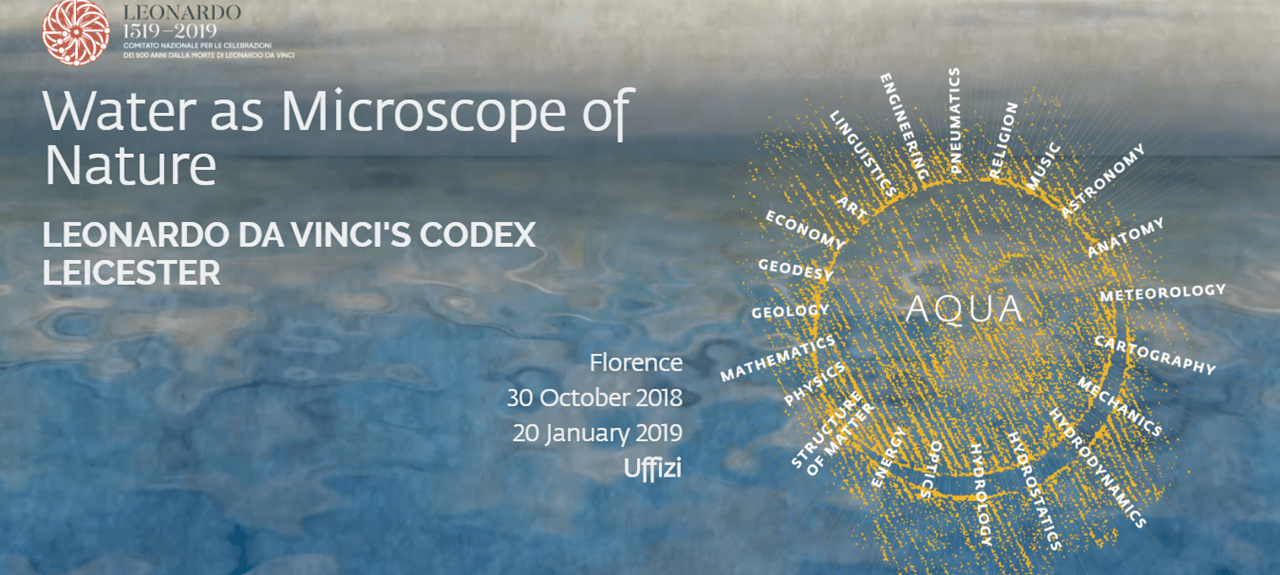
Almost 400,000 people visited the exhibition and stared in amazement at Leonardo’s writings. Individual folios were displayed in vertical glass cases which allowed visitors to read the recto and verso sides of each page while moving through the dark, arched room.

The exhibition room and two of the codescopes.
The curatorial team, guided by the director of the Galileo Museum, decided in fact to group folios according to topics while several codescopes were installed in the space to allow visitors to virtually flip through the pages of the Leicester Codex, thus reproducing the order in which the folios were bound together. Thanks to the codescopes, it was also possible to browse the codex and eventually visualize transcriptions of the text while getting information on some of the most significant issues addressed by Leonardo, particularly the physics of water movements, the structure of the Moon, and the history of the Earth.
As the exhibition title suggests, water intrigued Leonardo perhaps more than anything else. In his writings, he discusses its nature, its movements, and the difference between springs, rivers, seas, and rain. Defining the mechanisms connecting all these different phenomena became almost an obsessive thought for him. In order to deal with this complex system of problems, Leonardo meticulously recorded observations from experience and compared them with existing sets of knowledge, drawing on a variety of sources and devising experiments to verify hypotheses.
Leonardo’s experiments on water. Video available on the exhibition website.
Although Leonardo’s myth in popular discourse undoubtedly plays a role in attracting visitors to events of this kind, it is remarkable that the curator managed to orient such a vast audience toward the manuscript pages and other forms of “row documents”. A variety of texts, such as other manuscripts, incunabola, and maps were, in fact, on display as Leonardo’s possible sources, thus fostering the interest of the public toward the historical processes that inform not only knowledge formation but also its circulation and legacy. The inclusion of such documents as Leonardo’s sources contributes to dismantle conceptions such as that of geniality or the irrelevance of history for scientific engagement, while stressing the role of education and tradition in any process leading to new knowledge.
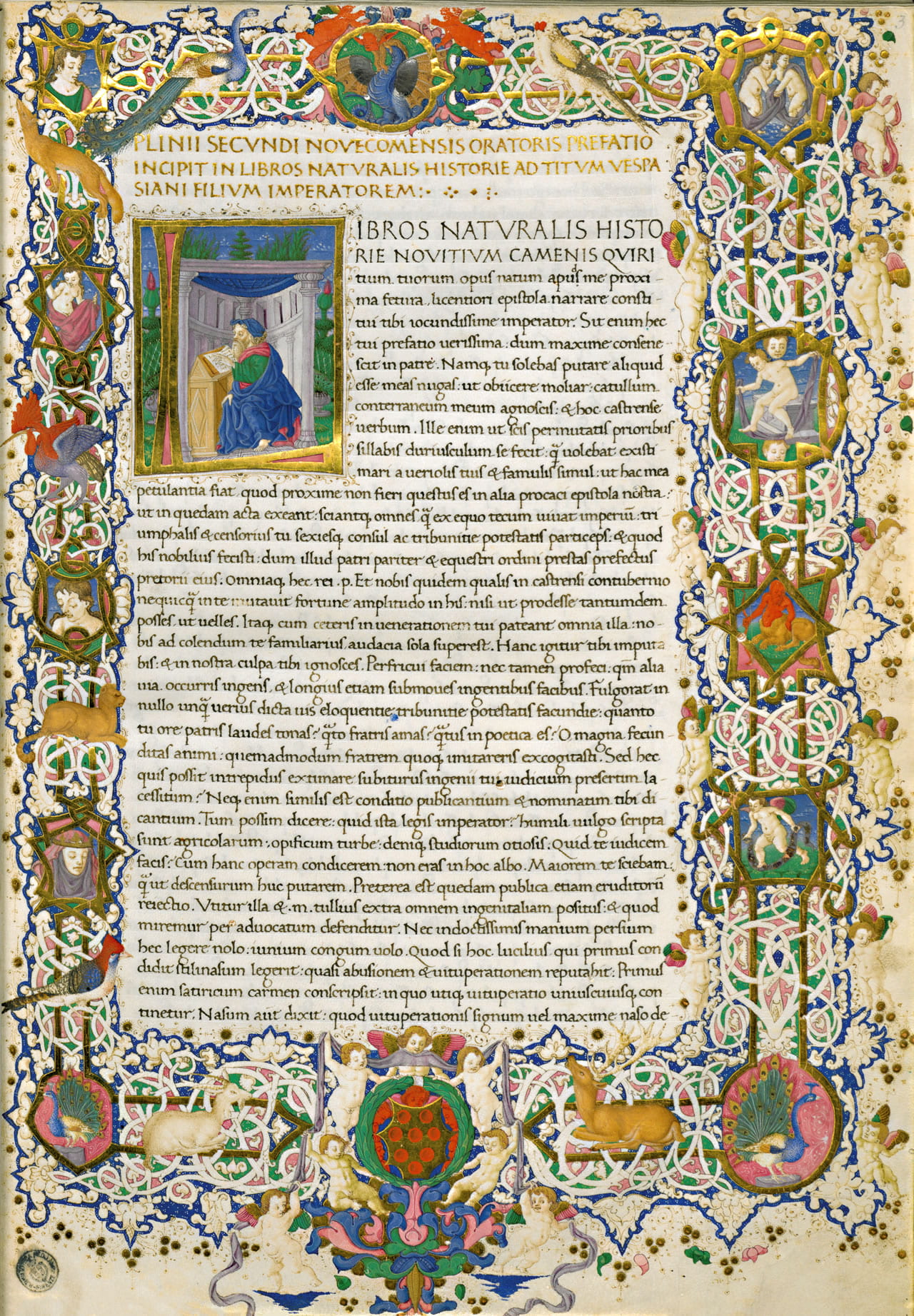
Pliny the Elder, Naturalis Historia (1458). Manuscript conserved in Florence at the Biblioteca Medicea Laurenziana, Plut. 82,4. Folio available on the exhibition website .
Certainly, some of the items that were on display also have an incredible aesthetic quality that captivated the audience and thus amplified the call for the significance of history that informed the exhibition. For example, among the manuscripts that were likely consulted by Leonardo for their relevance on the questions of the nature and physics of water were a 13th-century manuscript edition of Ristoro d’Arezzo’s La compositione del Mondo (The composition of the world) now conserved in Florence at the Biblioteca Riccardiana, and a 15th-century illuminated manuscript of Pliny’s Natural History, which belonged to the Medici Family and is now part of the collection of the Biblioteca Laurenziana in Florence. Remarkably, almost to reiterate the importance of access to sources and of history in the making of knowledge, all the materials that were part of the exhibition, including the curatorial narrative, are now available for public consultation on the official website.
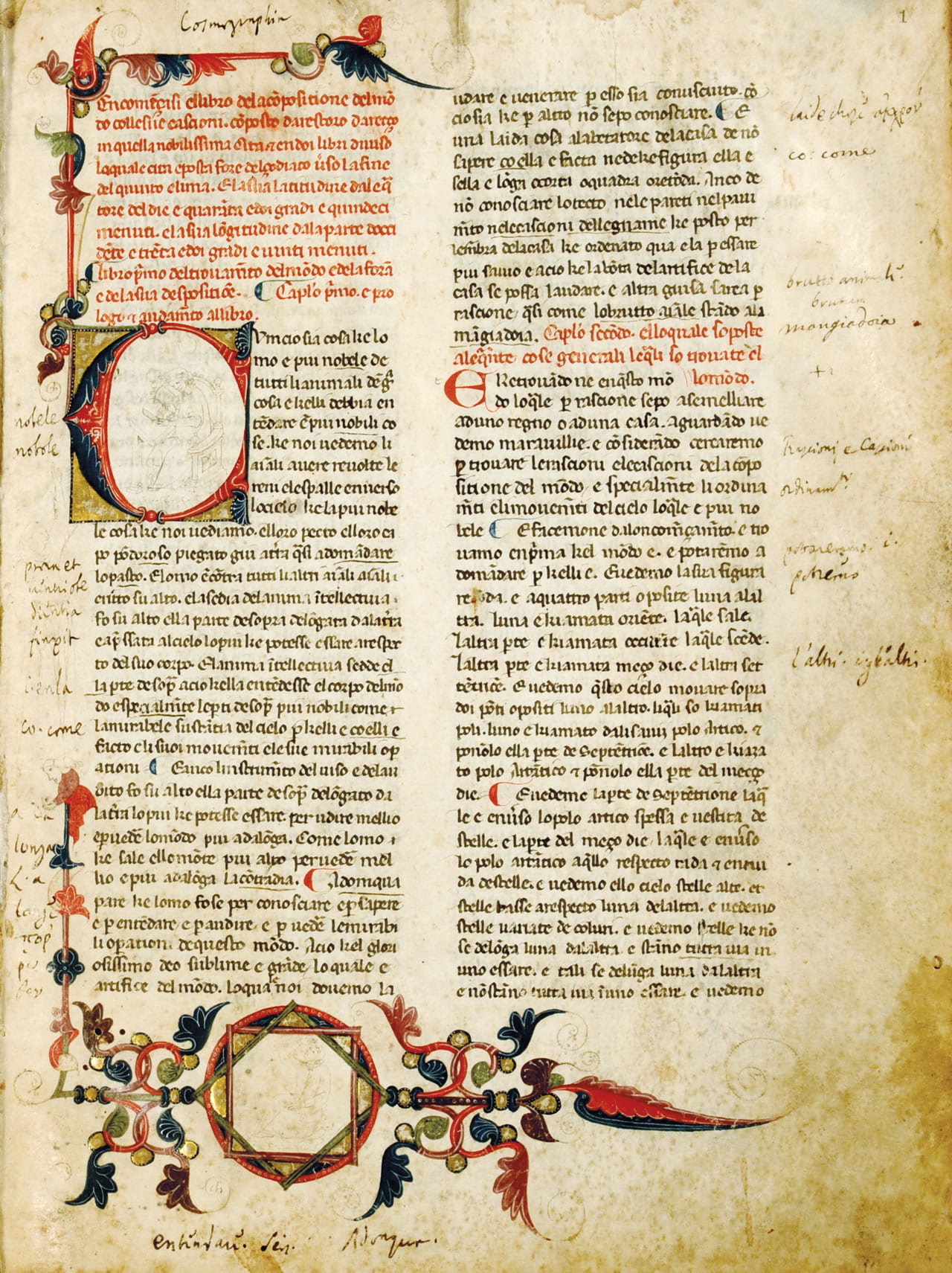
Ristoro d’Arezzo, La composizione del mondo con le sue cascioni (XIII century). Manuscript conserved in Florence at the Biblioteca Riccardiana, Ricc. 2164. Folio available on the Exhibition website.
Although some of the celebratory language and the Promethean tones informing the curatorial narrative might sound overwhelming for many science historians, this exhibition was particularly interesting for assessing the way in which the dualism art/science can still characterize public discourse around figures who would actually be functional to question such a divide. Leonardo is, in fact, a pivotal figure for any discussion on the relationship between artistic practice and scientific thought and can spark interesting considerations on the benefits of interdisciplinarity.
While walking through the exhibition and learning about Leonardo’s reflections, it becomes clear that much of the audience’s amazement stems from the variety of tools and languages on which Leonardo could draw to investigate problems of physics, mechanic engineering, and geology. Together with geometrical representations illustrating physical problems, the Codex also includes an “image bank” and several attempts to develop a lexicon for describing water.
Thus, much could be said on the curator’s decision to keep the two parts of Leonardo’s work separate, even if motivated by practical reasons, such as the absence of alarm systems in the space that was used for the temporary exhibition. Leonardo’s paintings, although referenced, were not in fact part of the exhibition which instead focused on documents, particularly manuscripts and maps, to position the viewer within that part of Leonardo’s work which is considered “scientific”. Unfortunately, the choice of material presented as well as the title seems to suggest the persistence of the dualism science/humanities when considering historical processes of knowledge making. On the contrary, Leonardo’s engagement with tradition, his open mindedness when combining historical research, field-work, and different languages for the investigation of problems, could have been easily presented as a model-story advocating for thinking across disciplines.
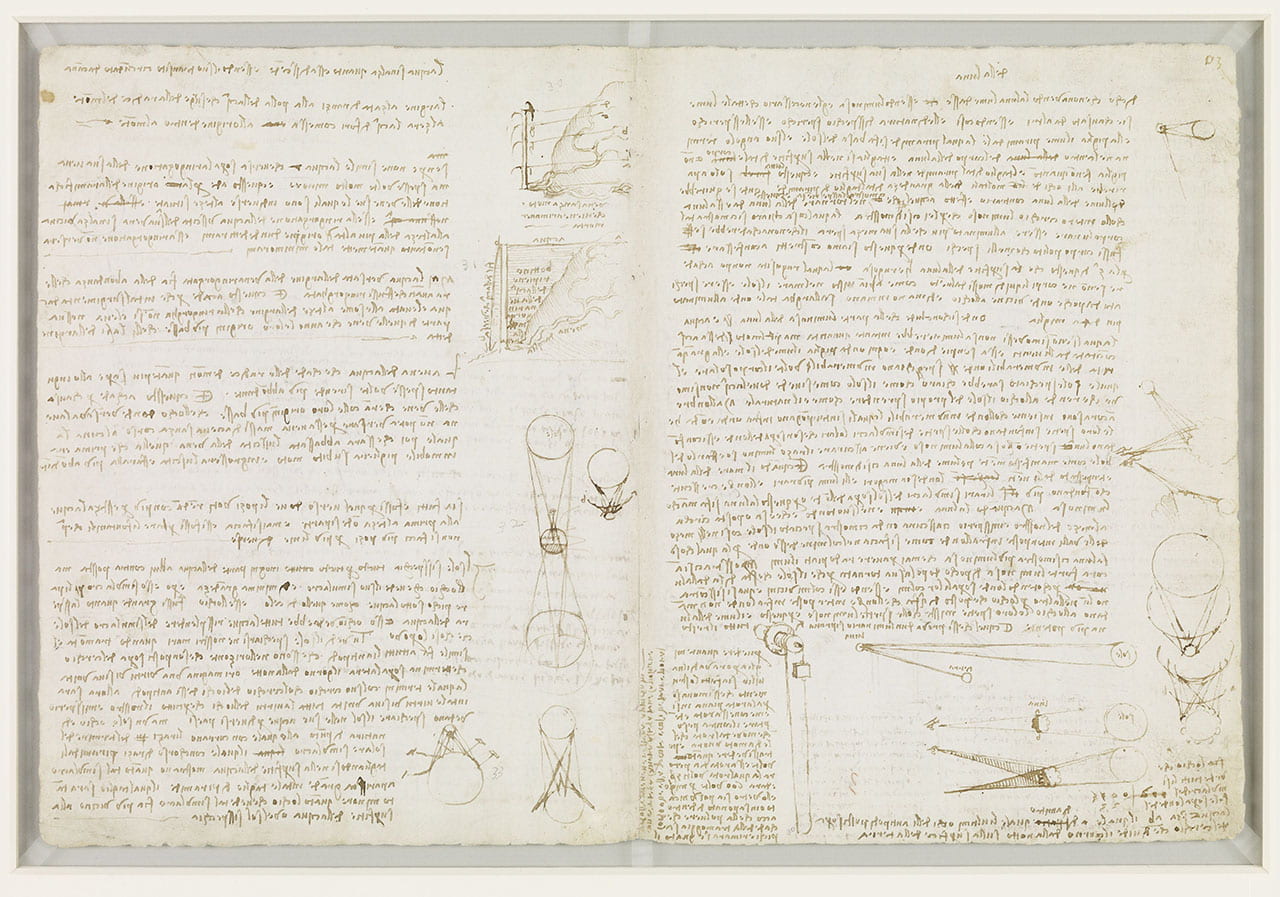
Leonardo da Vinci, Leicester Codex (1501-1508). Folio 7v and 30r. Available on the exhibition website.
Hopefully, this beautiful show will be of inspiration for more exhibitions that are able to work across the division between art and science when presenting historical process of knowledge formation to the public. With this in mind, we look forward to the upcoming exhibition “Leonardo da Vinci: a Mind in Motion” in London at the British Library this summer.
“Water as Microscope of Nature” was on view at the Gallerie degli Uffizi in Florence, Italy from October 30, 2018 to January 20, 2019. The exhibition was accompanied by a beautiful catalogue (available in Italian or English).
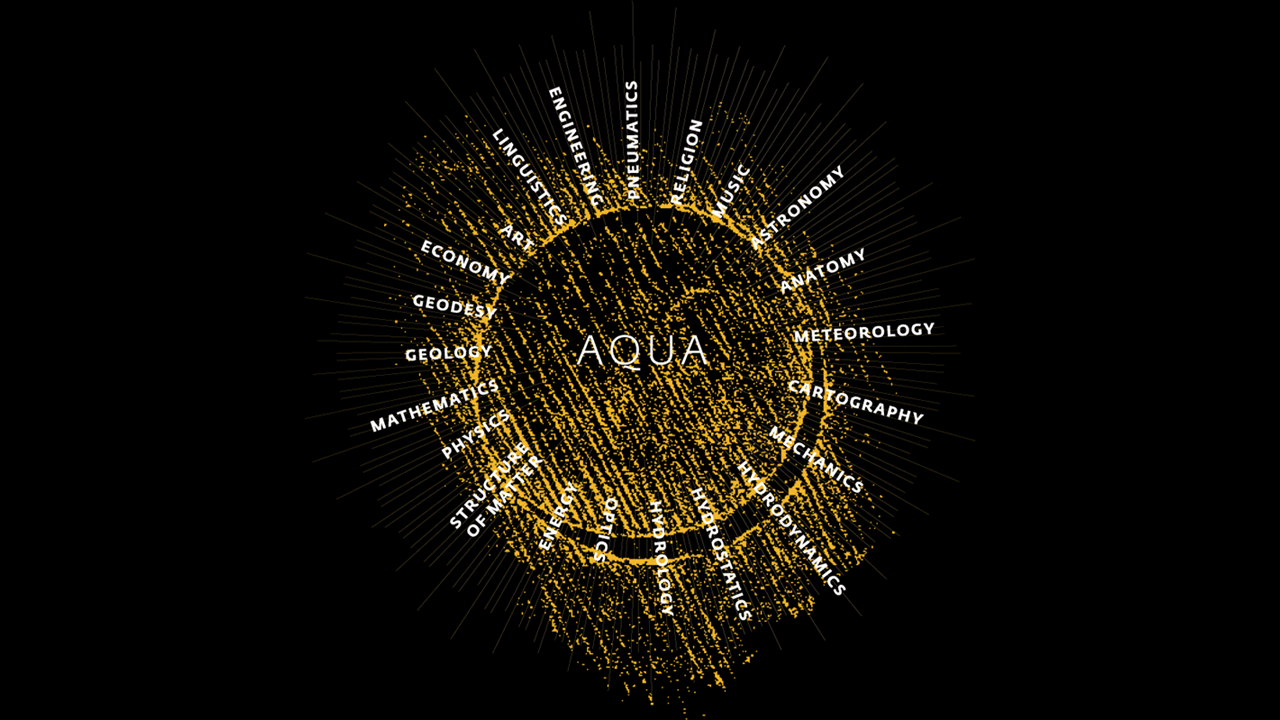



Leave a Reply